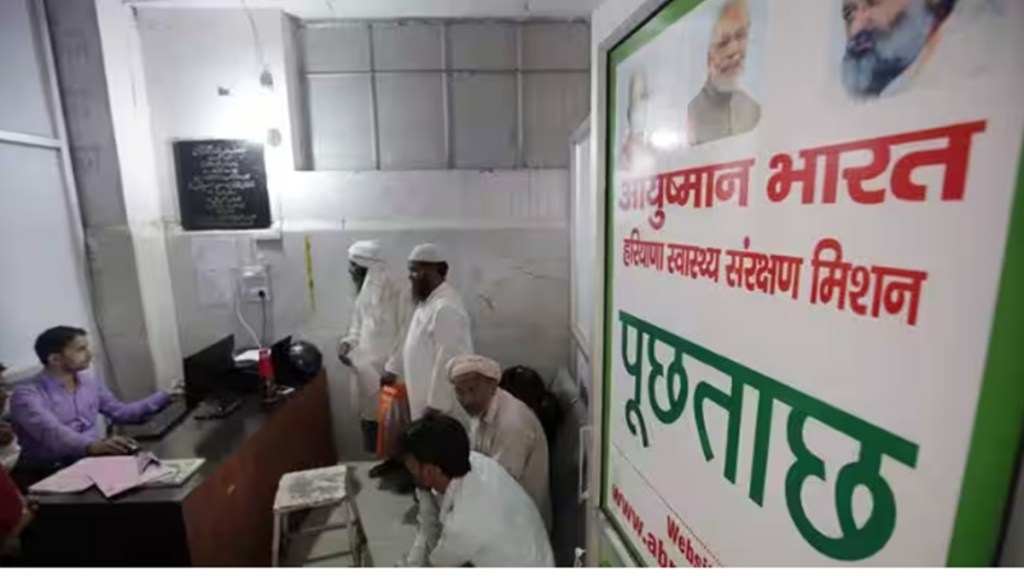By Furqan Qamar
In a country where more than 80% of the population is deprived of public health care, a quarter of the population cannot afford medical treatment without taking loans, and 17% of people spend up to 10% of their budget on healthcare due to limited access to public health facilities, any scheme promising to provide free healthcare to people in poverty is a boon.
So is the Ayushman Bharat Pradhan Mantri Jan Arogya Yojana (PMJAY). It was introduced in 2018 to cover healthcare expenses up to Rs 5 lakh per family to 40% of the country’s poorest 12 crore families, or 55 crore individuals. It covers the costs of hospitalisation, procedures, and medicines. It also covers pre- and post-hospitalisation treatments without any out-of-pocket expenses by any member of the registered beneficiary families.
PMJAY has already been implemented across all states and union territories barring Delhi, Odisha, Telangana, and West Bengal. By November 2022, 7.87 Crore families were registered under the scheme against the targeted 10.74 crore.
PMJAY has all the technological supports that are espoused to make the system transparent and foolproof: Beneficiaries are identified and registered by the Beneficiary Identification System (BIS); hospitals and healthcare providers are empanelled through Hospital Management Module (HEM), and expenses are booked through the Transaction Management System (TMS). It is implemented and managed by the National Health Agency (NHA), State Health Agencies (SHAs) and District Implementation Units (DIU). National and State Anti-Fraud Units (NAFU and SAFUs) have also been set up to eliminate possibilities of errors and fraud. So, it is confounding that the performance audit of the first three years of the scheme by the Comptroller and Auditor General of India (CAG) would report so many deficiencies.
Nearly a million beneficiary families were registered using the same or invalid mobile numbers. This could deny them access to healthcare if they lose their identity card. Beneficiaries are supposed to be identified based on the Match Confidence Score (MCS) generated by BIS. It is perplexing that 47.09% of the registered beneficiaries had zero or invalid scores. All the more puzzling is that 40.65% of those denied registrations had MCS between 51- 100.
The audit reports note that healthcare providers filed 2.15 lakh claims for treating patients who had been declared dead during earlier treatments. It is a surprise that claims worth `6.97 crore were processed, accepted, and paid. A good number of claims were also filed for patients who were discharged even before the date of their hospitalisation.
PMJAY requires Aadhaar verification of the beneficiaries. Patients without the Aadhaar card may access healthcare in the first instance on the condition that they must have their Aadhaar card when they come for subsequent treatment. According to the audit report, claims worth Rs 7,322.33 crore were paid off on account of 56.56 lakh patients, of which only 5.46 lakh were authenticated by their Aadhaar.
A third of the empanelled hospitals did not meet the minimum eligibility requirements; many lacked the necessary facilities, instruments, healthcare professionals and doctors. Quite a few submitted reimbursement claims for treating patients even after their empanelment was cancelled. Seven State Health Authorities (SHAs) reappropriated their allocations from one budget head to another, while 20 could not utilise their budget.
The NAFU referred 33.11 lakh cases to the SAFUs for investigation. Surprisingly, 40.81% were found to be fraudulent. Considering that only 17.56% have been absolved of fraud, the numbers and proportion may rise as a large number of cases are still under investigation or waiting for their turn to be taken up. Nearly 184 hospitals across 13 states/UTs were fined Rs 17.28 crore, of which only Rs 4.96 crore could be recovered. Data on penalties and recoveries were simply unavailable in as many as 15 states.
These discrepancies and deficiencies aside, the number of beneficiaries accessing healthcare under the scheme is highly skewed. As of November 2022, a quick analysis of the data reveals that 3.98 crore claims worth `48,486 crore were paid off. Nearly 90% of these payments were usurped by 12 states. Most of these states are reckoned as relatively more developed. Maharashtra and Karnataka, for example, expropriated 13.22% and 10.27% of the total outgo. UP and Bihar, on the other hand, could get no more than 3.54% and 0.95%. These deficiencies relate to the initial three years of the scheme, but they hint at more than teething troubles and call for immediate corrective action.
PMJAY was closely monitored using artificial intelligence (AI) and machine learning (ML) tools. It was supposed to be free of any loopholes. Ubiquitously, technology helps, but only to an extent. It is invariably found faulting in preventing the propensity and ingenuity of the vested interest.
RSBY was found wanting in the speed of implementation. PMJAY was implemented rather rapidly. Too speedy an implementation of any scheme often compromises caution. This must make us beware of the popular adage savdhani hati, durghatna ghati (accidents happen when one is not paying attention).
These findings must also make us reflect on why such publicly funded schemes implemented by private players often suffer from such fallibilities.
The writer is professor, Jamia Milia Islamia
Views are personal

